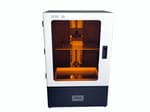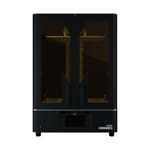Epax is going big. Real big. Recently, the manufacturer has expanded its lineup with a bunch of different-sized resin 3D printers, with the relatively small Epax E6 and the larger Epax E10 arriving prior to this behemoth of a resin 3D printer – the Epax X156.
Packing a 345 x 194 x 400 mm print volume, this goliath is one of the largest commercially available resin 3D printers. With its 4K RGB screen, it is capable of producing prints at 90 microns granularity, but the printer can be upgraded with a 4K monochrome screen and even an upcoming 5K mono screen.
Priced at $2,800, this printer is aimed at professionals and businesses with the need to print absolutely massive objects (or batches of objects) who have a wad of cash at hand. But will this be enough of a draw against the likes of the looming Phrozen Sonic Mega 8K?
Read on to find out, as we’ve compiled everything we know about it.
Features
Massive Build Volume
If there were an equivalent app for catching resin 3D printers similar to PokemonGo, your Resindex would probably be pretty crowded these days. MSLA resin 3D printers are popping up left, right and centre, but one with a truly large build volume, such as this Epax X156, is still a rare sight, even if you were to comb through all the high grass of Kanto.
With a 346 x 194 x 400 mm build volume, the Epax X156 is about as big as commercially available resin 3D printers get. For engineers and designers looking to make larger, detailed parts for end-use products, prop-making, or even batch production of smaller parts, the Epax X156 could prove an essential tool for the workshop. Without sacrificing detail (too much, more on it below), Epax has managed to create a machine capable of printing parts as large as a full-sized adult’s helmet in one solid print.
4K RGB Screen
Printing large, or in the X156’s case extra-large, is one thing. Printing highly detailed is another.
The Epax X156 houses a 15.6-inch 4K RGB screen. With 3840 x 2160 pixels spread across its 346 x 194 mm build surface, the printer can produce prints with an XY accuracy of 90 microns.
To adamant followers of the current status in resin 3D printing, this might not sound too impressive at first, as there are resolutions as low as 35 microns, such as on the (by comparison tiny), recently announced Elegoo Mars 3 and even other large printers such as the Phrozen Mega 8K with its build volume of 330 x 185 x 400 mm and a resolution of 43 microns. In general, the larger a screen is the more K (pixels) it needs to keep down those micron numbers, as pixels have to spread across a wider area.
If you would compare a small and detailed print of the X156 to some of the above-mentioned, up close, you would probably be able to spot a slight difference in granularity. Nevertheless, you can still produce pretty high detailed prints way cleaner compared to what you would get on an FDM machine.
No Mono screen
The screen currently used on the Epax X156 to mask the layers is RGB. Compared to the monochrome successors you will find on most resin 3D printers these days, the RGB screens absorb more light and therefore need longer curing times per layer as well as more timely replacement, as the prolonged exposure deteriorates the screen’s pixels quicker.
Typically mono screens last about four times longer than the ~500 hours of use you would get on a non-mono equivalent, and layer curing times would be around a third of the 8-10 seconds you will need on the Epax X156. So, it looks like Epax is a bit behind the times here
Screen Upgrades
Or is it? Upon release, Epax already provided upgrades to the X156 – primarily a 13.3-inch monochrome 4K screen the company uses on its X133 resin printer. The screen mounting bracket on the X156 is modular, and you can upgrade the printer yourself. The 13.3-inch mono screen will shrink down the print volume to 293 x 165 x 400 mm, but allow the X156 to produce prints at an XY accuracy of 76 microns alongside the additional benefit of lasting longer and printing (layers) faster.
We have it from Epax that a 15.6-inch 4K mono screen and even a 5.5K mono screen upgrade kit for the X156 is in the works and should find its way to the shop sometime this fall. However, keep in mind that monochrome screens, while lasting longer, are more expensive to replace.
Improved Fep Foil
Like previous Epax releases, the X156 features the brand’s nFEP (non-FEP) foil made from a special blend of Teflon.
Epax claims the foil is smoother than conventional FEP films, has high-temperature resistance (the array of LEDs needed to light up the massive build area produce quite a lot of heat), and provides greater air permeability, resulting in less vacuum suction force. The larger a print is, the more peel force applies every time the print plate lifts after curing a layer. This should mean fewer print artifacts and failures.
Connectivity & UI
The Epax X156 houses a ChiTu mainboard and runs on ChiTu firmware, which offers an easy-to-use interface that lets you control the printer via its 3.5-inch color touchscreen.
As such, ChiTuBox might be your go-to slicer. It is a highly capable resin slicer with everything you need for successful resin 3D printing. For the more professional user, ChiTu released a ChiTuBox Pro version that gives you even greater control of your prints with functions such as professional all-in-one model repair, multi-parameter slicing, and much more.
However, the Epax X156 is not confined to any proprietary software and can be used with multiple slicers, such as Lychee – another powerful resin slicer.
To transfer the sliced files from your computer to the X156, you can either use a USB stick or connect the printer via its Ethernet port. Unfortunately, Wi-Fi connectivity is not an option at the time of writing.
Sturdy Build
The Epax X156 has a tank-like build, weighing in at around 45 kg. Epax even issues an extra warning, advising you to move or install with at least two people. Probably solid advice.
Apart from being super heavy, its robust construction should counter any unwanted vibrations during printing. Its dual linear rail guides should provide the lead screw with guidance to move more precisely and minimize Z-wobble issues, resulting in a reliable and consistent operation.
Further Features
Additional features on the Epax X156 include:
- A factory-leveled printing plate with a manual leveling system
- A sandblasted, angled print plate with large handles for convenient operation
- Huge metal resin vat with a capacity of 2.5 liters

Reviews
The Epax X156 was released in early 2021, and the company seems to have sent out some machines to community-known-makers, primarily on YouTube, to review. At the time of writing, you can find a fair share of reviews saying the printer offers a solid print performance and boundless printing capabilities due to its sheer size, but also pointing out its rather slow production time.

Price
At the time of writing, the Epax X156 15.6-inch 4K version sells for ~$2.800.
Epax also lists a bundle combing the X156 15.6-inch default version with the 13.3-inch monochrome screen for $3.400. It is currently listed as sold out, though, so if you want to upgrade your printer, you will have to source the mono screen from Epax directly for an additional $549.
If you do want to print that big, you also need a big wallet. But Epax also sells refurbished X156 units via its website at a discounted price. That’s something we don’t see too often, but we quite like the thinking.

Tech Specs
General Specifications
- Technology: MSLA
- Type: Resin
- Year: 2021
- Assembly: Fully-assembled
- Manufacturer: Epax
3D PRINTING SPECIFICATIONS
- Build Volume: 345 x 194 x 400 mm
- Layer Height: 10 microns
- XY Resolution: 90 microns (3840 x 2160 pixels)
- Z-axis positioning accuracy: N/A
- Printing Speed: N/A
- Bed-Leveling: Factory leveled, manual
- Display: 3.5-inch color touchscreen
- Third-Party Materials: Yes
- Materials: 405 nm UV resin
SOFTWARE REQUIREMENTS
- Recommended Slicer: ChiTuBox
- Operating system: Windows / macOS X / Linux
- File types: STL
- Connectivity: USB, Ethernet
DIMENSIONS AND WEIGHT
- Frame dimensions: 508 x 431 x 787 mm
- Weight: 45 kg
- Boxed size: N/A
- Weight (packed): N/A

Similar Printers
You may also be interested in the following printers:
For further information, feel free to check out our Best Large Resin Printers Guide.
Peopoly Phenom L
The Phenom L is Peopoly’s equivalent to the Epax X156. It features an identical build volume of 345 x 194 x 400 mm, an XY-resolution of 90 microns, and a 4K RGB screen. It costs about the same but does not provide the ability to be upgraded to a monochrome screen.
Phrozen Sonic Mega 8K
If you can lose a little build volume and want finer granularity, the upcoming Phrozen Mega 8K might be an interesting alternative for you. With a print volume of 330 x 185 x 400 mm, it is not that much smaller but can produce fast prints with a 43-micron resolution, thanks to its 8K monochrome screen. Priced at $1,600, it is comparatively cheaper to boot.
License: The text of "Epax X156: Specs, Price, Release & Reviews" by All3DP is licensed under a Creative Commons Attribution 4.0 International License.
CERTAIN CONTENT THAT APPEARS ON THIS SITE COMES FROM AMAZON. THIS CONTENT IS PROVIDED ‘AS IS’ AND IS SUBJECT TO CHANGE OR REMOVAL AT ANY TIME.





